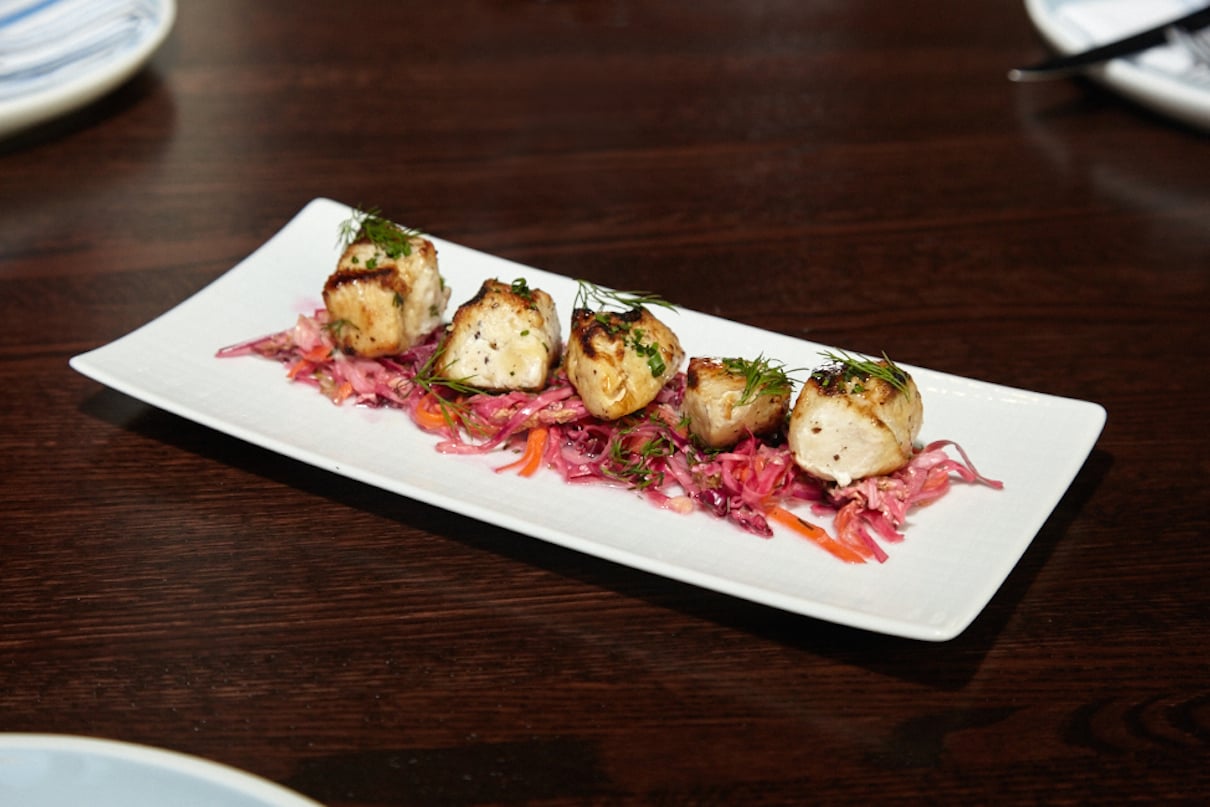
William Gutierrez hands me a fragrant cup of his pride and joy: Santa Lucia Estate coffee, served in more than 100 area restaurants, not to mention the Washington Convention Center, Ronald Reagan Building, and soon the Supreme Court.
But he won’t let me drink it.
“No!” says Gutierrez, throwing his hand over my wrist as if he’s saving me from poison. “Wait! It gives the real taste when the coffee is room temperature—what we call natural stage.”
Natural stage is where I’d like to be, having skipped my morning fix of joe in anticipation of enjoying a lot of Santa Lucia Estate—the fair-trade, high-altitude, donkey-transported coffee that Gutierrez has been importing for the past decade from a 400-acre Nicaraguan plantation.
Instead we’re standing in the Rockville Whole Foods Market—one of 26 that’s been selling Santa Lucia Estate beans since last year—watching Gutierrez’s wife and business partner, Jodi Lehr, hand out steaming samples. Shoppers down them immediately while we swirl ours in our cups, looking a little like Miles and Jack in Sideways.
Which is apt, because coffee is slowly being “vinified”—marketed by terroir, reserve status, bean classification, artisinal processing, all the markers of boutique quality that chefs and foodies fetishize. The concept of estate coffee—beans known and sold by the plantation’s name—is the leading edge of the industry.
And Gutierrez, one of the idea’s pioneers, has built an almost $2-million business—as well as a nice house in Potomac—by preaching estate-coffee religion to the most exacting chefs in Washington, one French-press pot at a time.
“He was the one at the advent of the coffee explosion,” says Jeffrey Buben, owner and executive chef of Vidalia and Bistro Bis, who has used Santa Lucia Estate for a decade.
Gutierrez—and now Lehr, who took over Santa Lucia Estate’s sales and marketing three years ago—has been able to sell perfectionists like Buben on the idea that they should choose their coffee as carefully as they choose their fava beans or their shoat. How? By presenting his product not as a commodity but as an education in taste—a public service with an elitist aura.
“We do not sell,” Gutierrez says. “We don’t have salespeople. We have passion for the product, and we introduce them to a new concept in coffee. If you like it, take it—if you don’t, don’t.”
Can I take it now, William?
“Go ahead,” he says. “But don’t just drink it. Take a sip and work it around your mouth, like Listerine—and then throw it to the back so it coats your throat, like tequila.”
I take a taste. But even now, 20 minutes old, the Santa Lucia Classic Roast—the lighter of the two Gutierrez offers—is very drinkable, a quick burst of acidity giving way to medium body and a light, clean flavor that endures. If you’re looking for room-temperature coffee, this is your stuff.
“Professionals, experts—what they call catadores in Spanish—they drink the coffee this way,” Gutierrez says. “There is no way you can BS the taste this way. You gonna walk around here and you gonna feel the taste in your throat for 10, 15 minutes. This is the main challenge—to educate the palate of the customer.”
We watch the Whole Foods shoppers dumping cream into their cups like they were putting out a fire. “You’re going to see—milk, sugar,” Gutierrez says, dropping his voice, as if we’re observing animals on a safari. “Ninety percent of Americans drink it that way, while in Europe 90 percent drink it black.”
“So nobody knows how to drink coffee here?” I ask.
“Few,” he says sadly, moving in close to impart yet another bit of philosophy: “Coffee is like a table—it has four legs.” Gutierrez counts them on his fingers: “The plantation. The roaster. The restaurant. And the customer. The four of them have to be synchronized for the guy drinking to have the maximum results.”
But when I ask Gutierrez if he’s going to educate these benighted folk, he puts his head down. “It’s a free country,” he says.
The appalling state of coffee in Washington’s restaurants before Santa Lucia Estate, according to Gutierrez—basically hot water chased through husks from a bagging floor, then served in scorched carafes not worthy of a gas station—is somewhat hyperbolic, according to most of his long-standing clients. (“The coffee was awful in restaurants before us,” Gutierrez assures me. “Black water. We came with a revolution.”)
However overstated, his contention does point to a larger truth: Despite the restaurant maxim that customers remember the beginning and end of a meal—that is, the bread and the coffee—chefs usually considered coffee an afterthought. And the almost laughably lucrative economics of coffee in restaurants bolstered that incuriosity.
“People don’t care,” says Gutierrez, who has charged restaurants around $6 a pound since he started selling Santa Lucia Estate. “One pound of coffee makes 50 eight-ounce cups. If you sell at $2 a cup, that’s $100—and you have $94 left. But still they didn’t want to switch.”
Gutierrez—a 50-year-old Nicaraguan native who came to DC in 1981 with a borrowed $20 in his pocket, fleeing conscription by the Sandinista regime—didn’t know much about coffee until he was nearly 40. Trained as a mechanical engineer, he fell into beans in 1994 after kicking around in jobs and schools from Washington to Italy to El Salvador, from a junior position at the Inter-American Development Bank to brokering sesame seeds, his first venture in Nicaragua. (When a friend of his father-in-law suggested the latter idea, Gutierrez had to look up “sesame seed” in the dictionary before he went down to look for deals.) Crop failure forced him out.
“Thank God, show up coffee,” Gutierrez says in his fractured syntax. Or rather, two coffee people showed up: Mario Cerna, an elementary-school friend and the owner of a coffee plantation named El Cielo, and David Dallis, a third-generation roaster and java geek based in Queens. Gutierrez had heard Dallis lament the poor quality of restaurant coffee at a convention. When he took Dallis some of El Cielo’s finest, the roaster loved it. The two hatched the idea of skimming off the best 25 percent of the plantation’s beans and selling it as Santa Lucia Estate.
“He made it his mission to seek me out and get me to travel to Nicaragua—and I am not a reckless guy by nature,” Dallis says. “I was a little nervous about going there; I didn’t know Spanish, just went based on trusting that this guy was going to meet me at the airport. And sure enough, William was there. He engendered trust in me immediately.”
Other roasters, though, didn’t trust Nicaraguan coffee, which had disappeared from the market in the 1980s during the US embargo of the Sandinista regime. So Gutierrez decided one night to take some beans to Galileo’s Roberto Donna, for whom Lehr had been working as an assistant. “The coffee was garbage at Galileo,” says Gutierrez, wide-eyed in horror. “It was institutional, prepackaged, stale. They used convenience-store burners.”
Donna wasn’t too sold on Santa Lucia either, at first. “Between you and me,” he says, “I would have served it anyway, because Jodi had worked for me for so long. But in the beginning it was a little too thin for me, a little watery. You drank it, and the coffee was gone.”
Gutierrez didn’t give up. He held a month of cuppings—tastings with different bean combinations and roasts—to fine-tune a blend to Donna’s liking. Finally Donna said yes and switched to Santa Lucia for press and espresso service. (Illy Caffè now does espresso for Galileo.) Gutierrez sold a grand total of 95 pounds and made $100 that first month—but he had bagged his first chef.
He began to collect them methodically, exploiting their referrals and the connections Lehr had made in a decade on the board of the local restaurant association. Gutierrez was a one-man band—sales, service, logistics. He held three months of Saturday-morning cuppings at Vidalia until Buben was satisfied; he bugged Steve DeCastro, owner of six Ruth’s Chris Steak Houses, for a year before DeCastro switched. Santa Lucia Estate now supplies about 45 Ruth’s Chris restaurants nationwide.
“I’ve never had anybody walk into my restaurant—out of millions of vendors—and say, ‘Hi, I sell beans,’ ” says Robert Wiedmaier, executive chef at Marcel’s. “You get the big corporate guys walking in here with their thermoses and their plans, but William and Jodi work from a very passionate point of view. It’s just not something you see in the industry.”
“You cannot find a more engaging storyÂteller,” Dallis says. “He has a perfect command of English, but he manages to mangle it in a funny way that’s calculated. People forget that they’re being sold—they’re insinuated instead into his story.”
Adds Donna, “When he puts his head into something, he makes it or he breaks it.” Or talks it to death: Gutierrez is infamous among area restaurateurs for marathon conversations and left-field metaphors. “He never shuts up,” Buben says. “The gift of gab is an understatement. He’d give you the shirt off his back. You just have to know when to duck out.”
Salvador Stadthagen, the Nicaraguan ambassador to the United States and a Gutierrez friend, says, “He’s a wonderful marketer—he could market anything anywhere.”
Behind all the talking, there’s the coffee. Dallis says it has a characteristically Central American medium body and acidity that make it attractive fare for restaurants—a versatile player that can back up a wide range of desserts, from a chocolate cheesecake to spun sugar. “There’s some structure there, and we can always blend in a little Sumatra if the customer wants more body,” he says.
That versatility, though, could also be read as having all the bite of smooth jazz—an inoffensive beverage, good for fueling conventioneers through an afternoon of panel discussions. Max Knoepfel, who was executive chef at the Washington Convention Center and now holds a similar post at the Belle Haven Country Club in Alexandria, says an all-ages appeal was a key reason he brought Santa Lucia Estate into both places. “Some people have coffee four or five times a day,” Knoepfel says. “And here at the club, we want a coffee that works for different age groups.”
Chefs who use the product say its quality is obvious. “It’s not overroasted or chocolatey—it’s sweet and beautiful,” Buben says. In other words, not aggressive, not young, not Starbucks—although Buben says he’s asked for a darker roast in the last two years in response to what he calls the “Starbuckization” of customers’ palates.
“We presented them with good quality coffee brewed at the quality temperature and brew strength in French presses,” recalls Dallis about the early days, adding that Gutierrez also instructed waitstaff on proper brewing techniques. “We were head and shoulders above what they were using. Once they realized that, it was just like dominoes; we’d get the next one and the next one.”
It wasn’t quite that easy. The price was an obstacle, and a few prominent chefs toyed with him, asking for weeks of cuppings and then spurning him. But landing chefs like Buben and Robert Wiedmaier of Marcel’s, who then ran Café on M in the Grand Hotel, convinced Gutierrez that he knew what he was talking about.
“Wiedmaier was a big boost,” he says. “I remember before I went to do the tasting with him, I pray: ‘God, illuminate me! Let’s make this coffee taste good! I hope the water, it tastes good! I hope the temperature becomes perfect!’ ”
Once the sale has been made, Gutierrez keeps working. For instance, he eats only at their restaurants. He shows up at their back doors 30 minutes after they’ve called for more supply. But chefs are fickle—especially with big corporate competitors constantly beckoning with golf vacations, free espresso machines, or Redskins tickets, even prominent photo-spread ads in culinary magazines. “We’re very temperamental,” Donna says. “If we don’t get good service, if we don’t get what we want when we want it and how we want it, we just go to somebody else.”
So Gutierrez invented his own estate-themed premium—a five-day annual January excursion to Nicaragua, first to El Cielo and then a virgin Pacific beach—for between 15 and 20 new clients, all expenses paid. (“Except for the prostitution and drugs,” Gutierrez says dryly.) The ride from Managua to the plantation takes about six hours—“four of them going straight up the side of the mountain in a four-by-four,” Buben says. Ten Nicaraguan Army soldiers ride with the chefs to deter kidnappers. “Last time we had Dan Mesches [owner of Red Sage and Zola], we had Roberto Donna, we had Jeff Tunks, we had Jeff Buben,” Gutierrez says. “I mean, people gonna stop eating in DC if something happen.”
The trip taxes Gutierrez’s chef-wrangling talents to the limit, especially the two-to-a-room accommodations. “These guys—the ego of the chef is as big as a watermelon,” he says. “I mean, these guys are used to their own penthouse! You can spoil the trip if you put one guy in a room with another he can’t stand. It’s like planning a dinner party.”
Despite the privations, the restaurateurs are rhapsodic about the experience. They arrive at the peak of the harvest—with 2,000 workers picking and transporting the red cherries that make the best beans—and follow the process through cleaning, washing, sun-drying in a courtyard, and cupping.
“It’s primal how it’s done,” Buben says. “It’s almost as if, after the beans are picked, every one has been visually inspected somehow. When you take a handful from the bag, you don’t see any broken or discolored beans. That’s what blew me away.”
“It was like going to Napa,” adds David Guas, executive pastry chef at Ceiba, TenPenh, DC Coast, and Acadiana. “It wasn’t until my first trip two years ago that I stopped putting dairy in my coffee. My father being Cuban, I grew up drinking 50-percent milk, 50-percent coffee. If you told that to William, he’d faint, or he’d yell at you.”
It was on January’s trip to El Cielo—over rum and fishing—that Gutierrez and a few of the chefs hatched his latest plan: the Santa Lucia Culinary Institute, to train young Nicaraguans in the culinary arts. “We would go to a hotel, and these chefs would say, ‘That guy at the front desk, we would love to hire him and take him back to the US,’ ” Gutierrez says.
The school—which would be for-profit but for which Gutierrez hopes to attract corporate and government sponsorship—would train 40 students a year to work for the chefs. After their visas expire, the idea goes, the grads would return to Nicaragua with savings and skills to open their own restaurants as that country’s tourism industry blossoms. “This is going to revolutionize Nicaragua,” Gutierrez says.
But at a June meeting at Marcel’s of more than a dozen restaurant and culinary professionals, the capitalism of the proposal becomes clear. In a presentation, Gutierrez’s partner, former Nicaraguan deputy secretary of commerce Javier Morales, says, “We are exploiting the arbitrage between low- and high-income markets,” citing Nicaragua’s annual per capita income of $850. “We will be giving these workers a world-class education using the lowest possible cost.”
Still, the restaurateurs whom the venture is designed to benefit are skeptical—some wondering how the school, with its requirement of English fluency, will attract the kind of lower-income workers they saw on the way to El Cielo. “I just don’t understand how this is going to work,” Gus DeMillo, co-owner of Ceiba, TenPenh, DC Coast, and Acadiana, blurts out at one point.
As ever, though, Gutierrez remains optimistic. Over lunch at his house in Potomac, Gutierrez recounts his own early days in the United States, a typical American-immigrant slalom of day jobs, nighttime English classes, and false starts. A steaming cup of his estate coffee sits in front of me at the kitchen table. Lehr poured one for each of us ten minutes earlier, and I have been asking Gutierrez for permission to pick up mine—permission he keeps denying. “Wait,” he says, waving me off again and again.
“How much coffee do you drink a day?” I ask.
“I don’t drink coffee,” Gutierrez says.
What?
“I taste it,” he says. “Because I grow up in Nicaragua. It is a very hot country. This is hot,” he says, pointing to the cup. “We drink juices, water. We don’t drink wines in Nicaragua.”
Says Lehr, “When I first went in 1990 with William to Nicaragua, the coffee was instant—it was horrible. All the good coffee would be exported.”
“I taste it,” Gutierrez says again, referring now to the cup in front of him, which he brings to his lips in a slightly delicate gesture. Lehr and I hold our breaths. “To me, that’s too strong,” he says, setting it down. “It start to get a little bitter at the end.”
I sip, swish, and toss back my own, searching for a bitterness I can’t find in the cooling brew. This constant correction by a taste professional—I find it pleasant. Gutierrez has sold me.
That is, until a minute or two later, he takes another sip of coffee and his face crinkles in puzzlement. “It’s better now,” he announces. “Not so bitter.”
Lehr and I look at each other, and I taste mine: No change. “William,” I say, “I think you need to drink more coffee.”
As his wife laughs, Gutierrez hesitates, his deep gray eyes darting between us. The coffee is good; life is good. For a brief moment, William Gutierrez is at a loss for words.
















